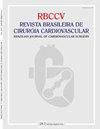冠状动脉搭桥术后胸骨后变形的罪魁祸首
IF 1.2
4区 医学
Q4 CARDIAC & CARDIOVASCULAR SYSTEMS
Revista Brasileira De Cirurgia Cardiovascular
Pub Date : 2022-05-23
DOI:10.21470/1678-9741-2021-0507
引用次数: 0
摘要
我们饶有兴趣地阅读了Bademci等人的文章“冠状动脉搭桥术后胸骨后变形的统计形状分析”。作者使用新颖的统计方法来证明冠状动脉搭桥术(CABG)手术后纵隔的几何变化。作者得出结论,冠脉搭桥后,“肺动脉主动脉接近胸骨”,“胸骨后区域变窄”。他们将这一发现归因于与心脏手术相关的炎症导致的疤痕组织和粘连的形成。我们想询问作者是否认为手术技术会影响纵隔的几何变化。外科医生在CABG技术、移植物的选择、心包闭合和体外循环(CPB)的使用方面差异很大。与非泵送CABG相比,非泵送CABG可能更有效地沉淀炎症过程。另一种产生较少炎症的技术是冠状动脉搭桥期间的微型体外循环(MECC)。因此,非泵送CABG或MECC血运重建术患者术后粘连和瘢痕组织形成可以减轻。CPB次数、输血、围手术期用药和患者因素也可能影响术后炎症反应的量。本研究患者组中与CPB及其他诱发炎症因素相关的数据可能具有相关性。插管策略也很重要,因为中央动脉插管比股动脉插管可能导致更多的胸骨后粘连。肺动脉导管的放置和肺动脉周围组织剥离的程度可能影响术后出现的粘连。为了进行统计形状分析,作者将既往CABG患者与无心脏手术史的对照组进行了比较。在我们看来,这忽略了纵隔解剖中人与人之间的几何差异。需要心胸外科手术的患者与不需要手术的患者的大血管大小可能不同。伴随心脏病的合并症,包括但不限于主动脉扩张或肺动脉压力升高导致大血管直径增大,可能使胸骨后距离[4]的比较复杂化。如果作者能够确定一组术前和术后进行胸部计算机断层扫描的患者,他们的方法可以用于明确评估冠脉搭桥手术对胸骨后粘连的影响。这也将允许控制或比较炎症的其他重要因素。我们祝贺作者在心脏手术中胸骨后粘连的研究。这项研究的结果可以指导心脏外科医生在重做手术时面临胸骨后粘连的危险。本文章由计算机程序翻译,如有差异,请以英文原文为准。
Culprits for Retrosternal Deformation After Coronary Artery Bypass Surgery
We have read with interest the article “Retrosternal Deformations after Coronary Artery Bypass Surgery Using Statistical Shape Analysis” by Bademci et al.[1] The authors have used novel statistical methods to demonstrate geometric changes in the mediastinum following coronary artery bypass grafting (CABG) surgery. The authors conclude that, following CABG, “the main pulmonary artery approximates to the sternum” with “narrowing of the retrosternal area”. They attribute this finding to the formation of scar tissue and adhesions which are the result of inflammation associated with cardiac surgery. We would like to inquire if the authors believe operative techniques affect the geometric changes in the mediastinum. Surgeons vary greatly in their CABG techniques, choice of grafts, pericardial closure, and use of cardiopulmonary bypass (CPB). On-pump CABG may precipitate inflammatory processes more potently compared to off-pump CABG[2]. Another technique that produces less inflammation is the mini-extracorporeal circulation (MECC) during CABG[3]. Therefore, postoperative adhesions and scar tissue formation could be attenuated in patients who are revascularized with offpump CABG or using MECC. It is also possible that CPB times, blood transfusions, perioperative medications, and patient factors affect the amount of inflammatory response in the postoperative period. Data related to CPB and other factors that induce inflammation in the patient group in the study may be relevant. The cannulation strategy is also important, as central arterial cannulation may result in more retrosternal adhesions than femoral cannulation. The placement of a pulmonary vent catheter and the extent of tissue dissection around the pulmonary artery may influence the adhesions present in the postoperative period. For their statistical shape analysis, the authors have compared patients with previous CABG with a control group without a history of cardiac surgery. In our opinion, this overlooks interpersonal geometric differences in mediastinal anatomy. The size of the great vessels can be different in the population of patients who require cardiothoracic surgery than individuals who did not require an operation. Comorbidities accompanying heart diseases, including, but not limited to, aortic enlargement or elevated pulmonary pressure increasing great vessel diameters, may complicate the comparison of retrosternal distance[4]. If the authors can identify a cohort of patients who had chest computed tomography before and after surgery, their methods can be applied to distinctly assess the effect of CABG surgery on retrosternal adhesions. This would also allow controlling or comparing other important factors in inflammation. We congratulate the authors for their study in the underexplored field of retrosternal adhesions in cardiac surgery. The findings from this study can guide cardiac surgeons who face the perils of retrosternal adhesions in redo operations.
求助全文
通过发布文献求助,成功后即可免费获取论文全文。
去求助
来源期刊

Revista Brasileira De Cirurgia Cardiovascular
CARDIAC & CARDIOVASCULAR SYSTEMS-SURGERY
CiteScore
2.10
自引率
0.00%
发文量
176
审稿时长
20 weeks
期刊介绍:
Brazilian Journal of Cardiovascular Surgery (BJCVS) is the official journal of the Brazilian Society of Cardiovascular Surgery (SBCCV). BJCVS is a bimonthly, peer-reviewed scientific journal, with regular circulation since 1986.
BJCVS aims to record the scientific and innovation production in cardiovascular surgery and promote study, improvement and professional updating in the specialty. It has significant impact on cardiovascular surgery practice and related areas.
 求助内容:
求助内容: 应助结果提醒方式:
应助结果提醒方式:


